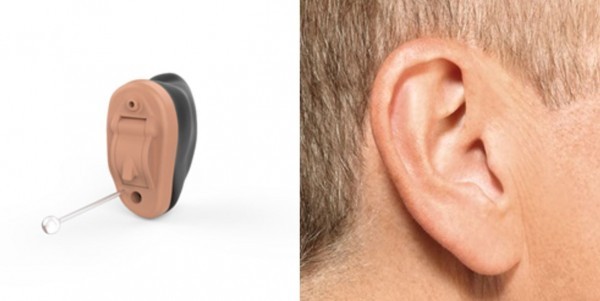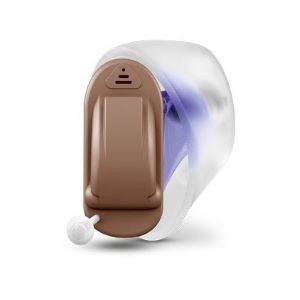Free home visits
with a local audiologist
Traditional hearing aids of the past are often associated with bulky and noticeable devices that can cause self-consciousness and social stigma. IIC hearing aids have changed all that and are designed to overcome these limitations.
Offering a discreet and effective way to enhance hearing capabilities these invisible hearing aids have revolutionised the hearing aid industry, providing individuals with a renewed sense of confidence and improved quality of life.

Is an Invisible in the Canal (IIC) hearing aid right for you? A recent study found that 40% of people would be more likely to wear a hearing aid if it were completely invisible to others and so with this in mind Invisible In the Canal (IIC) hearing aids have been developed over the last few years.
They are very similar to Completely in the Canal (CIC) hearing aids except that they are slightly smaller and are worn slightly further down into the ear canal. This means that they are completely invisible even if someone were to look directly into your ear.

Inevitably with this reduction in size, there are some compromises on battery life (due to the smaller sized batteries) and the number and power levels of the technological features that can be included.
However, if you only suffer from mild to moderate hearing loss and discretion is a priority for you then an Invisible in the Canal (IIC) hearing aid could be exactly the style of hearing aid that you have been looking for.
Invisible in the Canal (IIC) hearing aids have numerous different advantages and disadvantages. Our information below details some of the most common of these, however for more details please contact our expert team today and we’ll happily talk you through all of the options available to you.

What are the advantages of Invisible in the Canal hearing aids (IIC)? The main reason that you would choose an Invisible in the Canal (IIC) hearing aid is that it is completely invisible to others. The only visible part is a small wire (that itself is usually incredibly difficult for others to see) that attaches to the aid which then protrudes just outside of the ear canal which you hold on to insert and remove the aid.
Another key advantage of invisible hearing aids is their cosmetic appeal. Many people with hearing loss are hesitant to wear hearing aids due to concerns about their appearance. Invisible hearing aids address this issue by blending seamlessly with the natural contours of the ear, ensuring that they remain virtually invisible to others.
This aesthetic advantage allows users to feel more confident in social settings and go about their daily activities without drawing unnecessary attention.
Obviously, due to their position completely within the ear canal, Invisible in the Canal (IIC) hearing aids can not include any on-aid controls. Therefore any adjustments need to be made via a dedicated external device.
Unfortunately, as they are inside your ear they cannot connect to a smartphone app, however many of the controls are very discreet and can be small enough to fit onto your keyring.
As Invisible In the Canal (IIC) hearing aids are made to a custom mould of your ear canal, and because their exact location within the canal means that they rest against a slight bony protrusion, they are incredibly comfortable to wear.
They will not move around inside your ear and many people report that they are completely unable to feel them at all.
Another advantage of Invisible in the Canal (IIC) hearing aids sitting so deeply within your ear is that you are still able to naturally detect which direction sounds are coming from. This is because it is still your outer ear that is funnelling sounds down into your ear canal.
Invisible In the Canal (IIC) hearing aids produce a very natural sound profile as most of your ear is still free to conduct its natural function. The hearing aid simply acts to receive sounds as they naturally enter the ear canal and then amplify them out towards the eardrum.
This allows for the sounds to keep the most natural profile possible.
Issues of wind noise distraction are completely eliminated with Invisible In the Canal (IIC) hearing aids, as a result of their position within the ear canal.
Because Invisible In the Canal (IIC) hearing aids sit completely within the ear canal they do not get in the way of your wearing helmets, headphones or any other type of headgear and you are also able to use your telephone completely naturally.
This makes them much more suitable for people with active lifestyles, or who find change challenging.

Because they are small enough to fit completely within your ear canal, Invisible In the Canal (IIC) hearing aids have to sacrifice the space for the inclusion of more powerful processors and amplifiers, some of the more advanced technological features, and the larger battery sizes that is possible in some larger hearing aid styles.
Also due to their position completely within the ear canal, there is no option for binaural communication between different hearing aids, meaning that if you wear two Invisible In the Canal (IIC) hearing aids then each will need to be adjusted separately.
They can also only incorporate one microphone, however, this is actually less of an issue that you might think as Invisible In the Canal (IIC) hearing aids do not tend to suffer from issues with sound directionality detection which dual microphones tend to address.
As Invisible In the Canal (IIC) hearing aids sit quite deeply within the ear canal, they are more susceptible to damage from the natural moisture within your ear and the buildup of earwax. This means that they require a higher level of often quite precise cleaning and maintenance to keep them in perfect working order.
To find out more about Invisible In the Canal (IIC) hearing aids, or any of the other types of hearing aids that are available, contact our advisors and let us help you find the right hearing aid today.
As they are very small, Invisible In the Canal (IIC) hearing aids can only hold the smallest battery sizes, this means that they are unable to support the more powerful processors and amplifiers that more severe levels of hearing loss require.
Also, the battery life of Invisible In the Canal (IIC) hearing aids is much shorter than for hearing aids styles which can accommodate larger battery sizes.
Because Invisible In the Canal (IIC) hearing aids completely fill the ear canal they can cause issues of occlusion such as; hearing your own voice louder or it sounding hollow, feeling that your ear is blocked or chewing and swallowing sounding noisy or unpleasant.
Larger hearing aid styles such as In The Ear (ITE) or In The Canal (ITC) can include a vent to circumnavigate occlusion issues, however, Invisible In the Canal (IIC) hearing aids are too small for this to be possible.
If your ear canal is unusually small or of a non-standard shape then you may not be able to get an Invisible In the Canal (IIC) hearing aid to fit. However, for the majority of people, this is not normally a problem.
As with much technology, the smaller it gets the more expensive it gets and the same can sometimes be said for Invisible In the Canal (IIC) hearing aids. Add that to their custom made design and they can be some of the most expensive types of hearing aids on the market.
However, if you choose to buy your Invisible In the Canal (IIC) hearing aid from HearingAid.org.uk then you will pay the same price regardless of which style of hearing aid you choose.
Obviously, Invisible In the Canal (IIC) hearing aids are unable to have controls situated on the aids themselves, so any adjustments to settings, volume or programmes have to be made via a dedicated external remote controller.
Their position deep within the ear canal also means that they are unable to connect via Bluetooth to a smartphone app. Most control devices are very small and discreet however the fact that they exist at all may be off-putting or unsuitable for some users.
Because they are so small and discreet, Invisible In the Canal (IIC) hearing aids can be unsuitable for users with dexterity issues, or potentially with visual impairments. The devices themselves are very small, as is the wire that is used for insertion and removal.
Also, practices such as general cleaning and maintenance and changing the batteries can be quite fiddly.
Invisible hearing aids have ushered in a new era of hearing technology. With their discreetness, advanced capabilities, comfort and versatility they have become a game-changer in the hearing aid industry.
To find out more about Invisible in the Canal (IIC) hearing aids, or any of the other types of hearing aids that are available, contact our advisors and let us help you find the right hearing aid today. Call us free on 0800 567 7621
You can look at our In-Ear hearing aid prices here
You can discover other hearing aid types here
Do not spend hundreds of pounds without getting a second opinion from us.
 Not only are the prices great, but the service is fantastic! Many thanks to your team.
Not only are the prices great, but the service is fantastic! Many thanks to your team.If you are looking at this page then it is likely that an audiologist has suggested that you purchase this particular hearing aid, so is this the best model for you?
In general, any audiologist will always recommend to you the model that best suits your needs. Here is a useful checklist to make sure that is the case.
If in doubt, feel free to give us a call. That's what we're here for. In the meantime, read all about our review of the best hearing aids for 2025 here
If you have significant hearing loss in both ears, you should be wearing two hearing aids. Here are the audiological reasons why:
Localisation: The brain decodes information from both ears and compares and contrasts them. By analysing the minuscule time delays as well as the difference in the loudness of each sound reaching the ears, the person is able to accurately locate a sound source. Simply put, if you have better hearing on one side than the other, you can't accurately tell what direction sounds are coming from.
Less amplification is required: A phenomenon known as “binaural summation” means that the hearing aids can be set at a lower and more natural volume setting than if you wore only one hearing aid.
Head shadow effect: High frequencies, the part of your hearing that gives clarity and meaning to speech sounds, cannot bend around your head. Only low frequencies can. Therefore if someone is talking on your unaided side you are likely to hear that they are speaking, but be unable to tell what they have said.
Noise reduction: The brain has its own built-in noise reduction which is only really effective when it is receiving information from both ears. If only one ear is aided, even with the best hearing aid in the world, it will be difficult for you to hear in background noise as your brain is trying to retain all of the sounds (including background noise) rather than filtering it out.
Sound quality: We are designed to hear in stereo. Only hearing from one side sounds a lot less natural to us.
Fancy some further reading on this topic? You can read about why two hearing aids are better than one in our article, hearing aids for both ears, here
For most people, the main benefit of a rechargeable hearing aid is simple convenience. We are used to plugging in our phones and other devices overnight for them to charge up. Here are some other pros and cons:
For anybody with poor dexterity or issues with their fingers, having a rechargeable aid makes a huge difference as normal hearing aid batteries are quite small and some people find them fiddly to change.
One downside is that if you forget to charge your hearing aid, then it is a problem that can't be instantly fixed. For most a 30-minute charge will get you at least two or three hours of hearing, but if you are the type of person who is likely to forget to plug them in regularly then you're probably better off with standard batteries.
Rechargeable aids are also a little bit bigger and are only available in Behind the Ear models.
Finally, just like with a mobile phone, the amount of charge you get on day one is not going to be the same as you get a few years down the line. Be sure to ask what the policy is with the manufacturer warranty when it comes to replacing the battery.
Looking for more information on rechargeable hearing aids? Read our dedicated page on the topic here
For most people, the answer is yes. But it's never that simple.
The majority of hearing problems affect the high frequencies a lot more than the low ones. Therefore open fitting hearing aids sound a lot more natural and ones that block your ears up can make your own voice sound like you are talking with your head in a bucket. Therefore in-ear aids tend to be less natural.
However the true answer is we can't tell until we have had a look in your ears to assess the size of your ear canal, and until we have tested your hearing to see which frequencies are being affected.
People with wider ear canals tend to have more flexibility, also there are open fitting modular CIC hearing aids now that do not block your ears.
There is also the age old rule to consider, that a hearing aid will not help you if it's sat in the drawer gathering dust. If the only hearing aid you would be happy wearing is one that people can't see, then that's what you should get.
Most people can adapt to any type of hearing aid, as long as they know what to expect. Have an honest conversation with your audiologist as to what your needs are.
Generally speaking, six or more. Unless it's none at all.
The number of channels a hearing aid has is often a simplistic way an audiologist will use to explain why one hearing aid is better than another, but channels are complex and it is really not that straightforward. Here are some reasons why:
Hearing aids amplify sounds of different frequencies by different amounts. Most people have lost more high frequencies than low and therefore need more amplification in the high frequencies. The range of sounds you hear are split into frequency bands or channels and the hearing aids are set to provide the right amount of hearing at each frequency level.
Less than six channels and this cannot be done with much accuracy, so six is the magic number. However, a six channel aid is typically very basic with few other features and is suitable only for hearing a single speaker in a quiet room. The number of channels is not what you should be looking at, it's more the rest of the technology that comes with them.
As a final note, different manufacturers have different approaches. One method is not necessarily better than any other. For example, some manufacturers have as many as 64 channels in their top aids. Most tend to have between 17 and 20. One manufacturer has no channels at all.
Hearing aids are easily lost, misplaced or damaged and typically are one of the most expensive personal possessions an individual can own. We offer hearing aid warranty coverage for £80 per year per aid. Find out more about this service we provide here
All our audiologists use the very latest technology and provide the full range of tests to accurately measure your hearing for free. Find out about what hearing healthcare services we offer all our customers here
Hearing Aid UK offers all their customers free home visiting services, even in a care home environment, for no extra cost. Including hearing tests, fittings, maintenance, check-ups and much more in the comfort of your own home and at your convenience. Find out more information about our home visits here
Here, at Hearing Aid UK, we are dedicated to offering low hearing aid prices. We achieve this by having no head office and low marketing costs. Our hearing aid prices are amongst the lowest you will find anywhere in the world. Explore our prices, brands, and models here
When we refer to a product as 'Latest Launch', we mean it is the latest to be released on the market.
When we refer to a product as 'New', we mean that the product is the newest hearing aid model on the market.
When we refer to a product as 'Superseded', we mean that there is a newer range available which replaces and improves on this product.
When we refer to a product as an 'Older Model', we mean that it is has been superseded by at least two more recent hearing aid ranges.